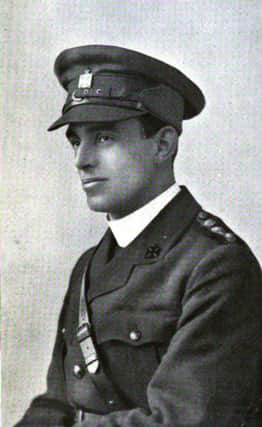Anniversaries with connections to Irish poet, Duke and American ranger


It’s remembered and celebrated as Waterloo Day, when the Duke of Wellington famously called his victory over Napoleon in 1815 ‘a close run thing’.
Every year around now Roamer gets reminded of Belfast’s Annadale Embankment beside the River Lagan, and its connections with the Iron Duke.
Advertisement
Hide AdAdvertisement
Hide AdThe Embankment was once known as ‘Anna’s dales’, where the Countess of Mornington, the Duke of Wellington’s mother, often surveyed her beautifully tended gardens on the riverside’s undulating drumlins.
Through time ‘Anna’s dales’ became the Annadale Embankment.
To another more recent anniversary on Saturday, June 17 when the Ranger Centre in Carrickfergus was re-opened at the weekend.
Commemorations and family events were held in memory of the US Army Rangers on the 75th Anniversary of their establishment.
Advertisement
Hide AdAdvertisement
Hide AdRegular Roamer-contributor Selwyn Johnston shared the day’s historic background, beginning early in 1942 when the US Army decided to raise a raiding force similar to the British Commandos.
General Russell P. Hartle was ordered to form the unit, to be known as ‘The Rangers’.
In May 1942 Company A of the 1st US Ranger Battalion was raised under Captain William Darby in Carrickfergus.
Darby, then promoted to Major, expanded the Company to a Battalion which underwent training in Auchnacarry in Scotland.
Advertisement
Hide AdAdvertisement
Hide AdOn June 19, 1942 they assembled in Carrickfergus, and were to become one of the US Army’s most courageous and most decorated units. Even their training was tough!
Their tally of 26 officers and 447 enlisted men was deliberately set at 10% above-strength to compensate for losses due to injury and also for those who returned to their units exhausted by their over-strenuous induction.
The 1st Battalion first saw action at Dieppe in August 1942, and went on to fight in North Africa, Sicily and Italy alongside the 3rd and 4th Ranger Battalions.
The 1st Battalion was deactivated in 1944.
Darby, promoted to a Colonel, was killed in an artillery attack in Italy in 1945 while commanding a regular army task force.
Advertisement
Hide AdAdvertisement
Hide AdThe 2nd and 5th Ranger Battalions were raised in the United States, sent to the UK for further training, and landed in Normandy on D-Day.
Their most famous action at Normandy was at Point Du Hoc on Omaha Beach, when a concerted attack by the combined 2nd and 5th Rangers created the momentum for the rest of the US forces pinned down on the beach to advance.
During this action, General Norman Cota (Executive Officer of the 29th Infantry Division) gave the Rangers their motto when he exhorted them forward with the words “Rangers, lead the way!”
The 6th Ranger Battalion was formed in the United States and fought in the Pacific Theatre.
Advertisement
Hide AdAdvertisement
Hide AdThere they participated in the ‘Great Raid’, freeing more than 500 POWs from the camp where they were being held by the Japanese near Manila.
The 29th Ranger Battalion, which was active between December 1942 and October 1943, was trained by a unit from the 1st Rangers and participated in a number of raids in Norway alongside British Commandos.
The name came originally from Rogers’ Rangers, a force raised by Major Robert Rogers in 1756 to fight in the French and Indian War, carrying out attacks deep in enemy territory.
The modern Ranger Creed, written in 1974, which all Rangers are expected to know by heart, is based on Rogers’ original ‘28 Rules of Ranging.’
Advertisement
Hide AdAdvertisement
Hide AdWilliam Darby read the ‘28 Rules’ to his Rangers before they went in to action in WWII. Given a new lease of life, the refurbished museum at the adjacent Andrew Jackson Cottage, Boneybefore, Carrickfergus, boasts new and visually striking displays which include previously unexhibited artefacts and photographs as well as extensive vintage film footage.
Full details are at www.midandeastantrim.gov.uk
A third anniversary has been referred to on this page several times recently - the Battle of Messines Ridge in West Flanders, Belgium, on June 7, 1917.
The week-long battle was of immense historic and symbolic significance for the UK and Ireland as it was the first time that the 36th (Ulster) and 16th (Irish) Divisions fought alongside each other during WWI.
Roamer has received a copy of a cutting from The London Gazette, published on August 14, 1917, headlined ‘Messines Ridge’.
Advertisement
Hide AdAdvertisement
Hide AdThe cutting, referring to Army Chaplain Rev. Geoffrey Anketell Studdert-Kennedy, announced:
“For conspicuous gallantry and devotion to duty. He showed the greatest courage and disregard for his own safety in attending to the wounded under heavy fire.
“He searched shell holes for our own and enemy wounded, assisting them to the dressing station, and his cheerfulness and endurance had a splendid effect upon all ranks in the front-line trenches, which he constantly visited.”
Awarded the Military Cross for his heroism at Messines, Army Chaplain Geoffrey Studdert-Kennedy was known as Woodbine Willie - the nickname that christened his iconic, anguishing poem about his mission in the trenches - “the men to whom I owed God’s Peace, I put off with a cigarette.”
Advertisement
Hide AdAdvertisement
Hide AdHis father William Studdert-Kennedy was born in Blackrock, County Dublin and his paternal grandfather was the Dean of Clonfert in County Galway.
Geoffrey went to Trinity College Dublin and his faith, courage and greatly loved poems all went into history.